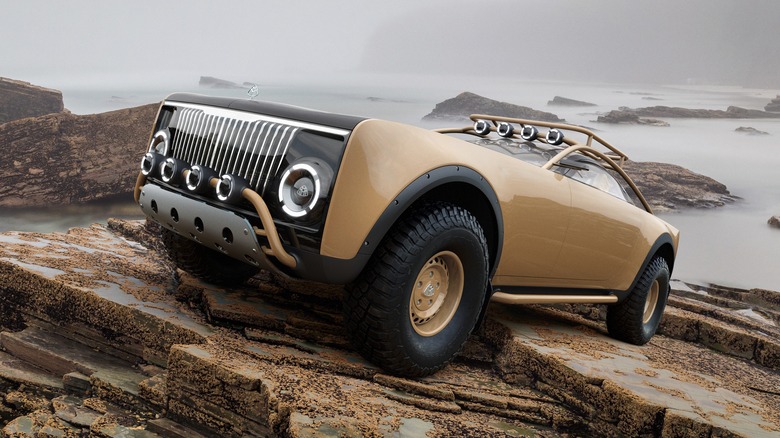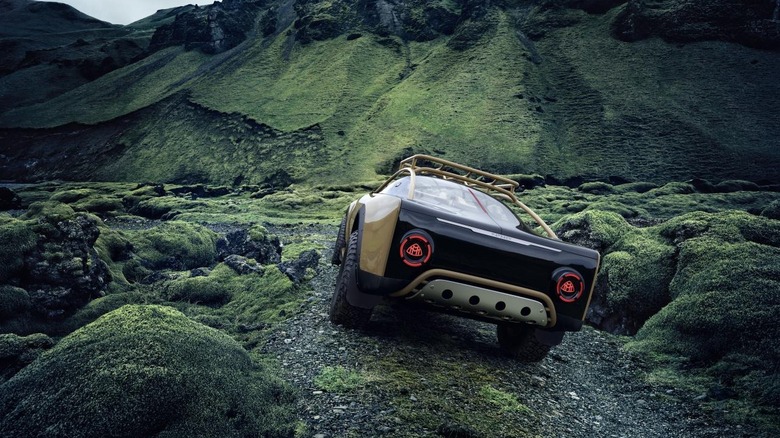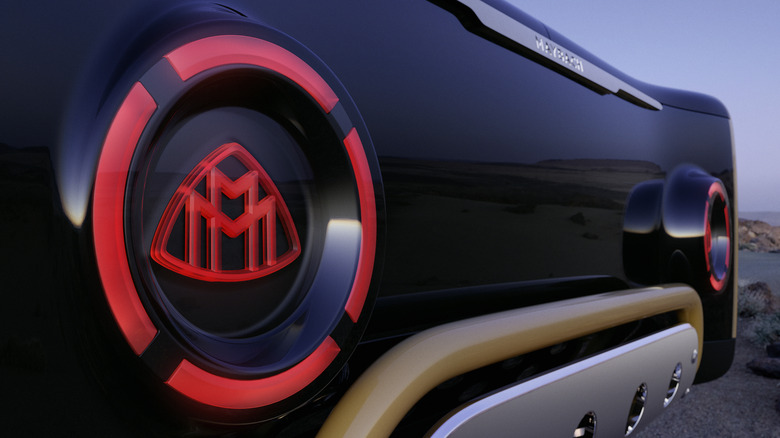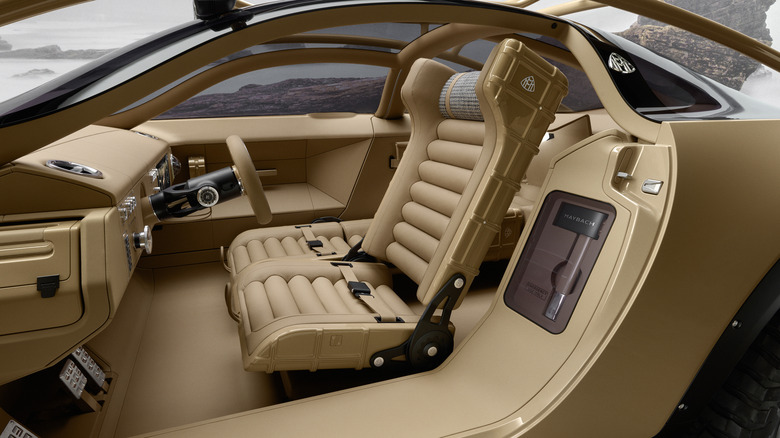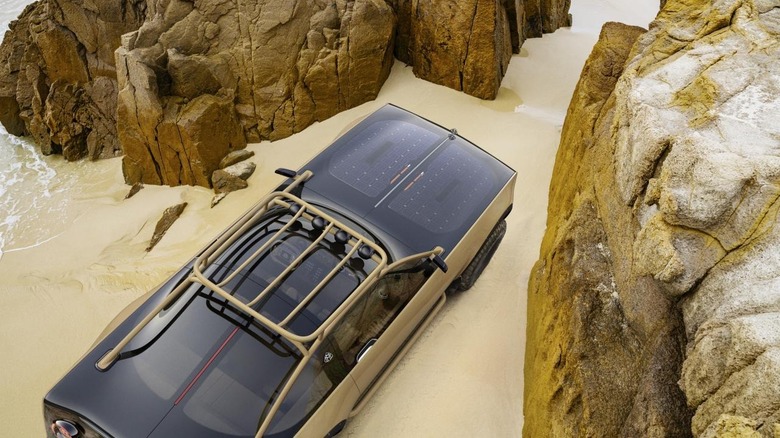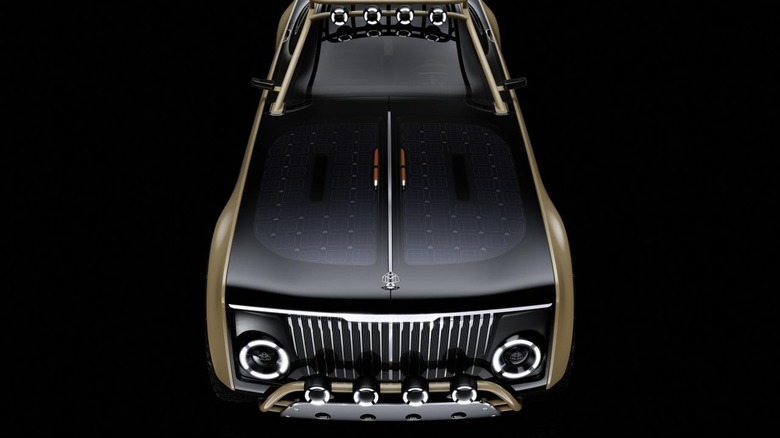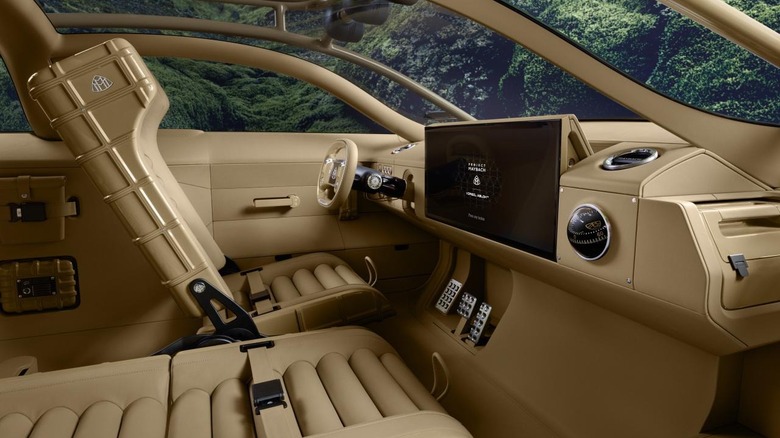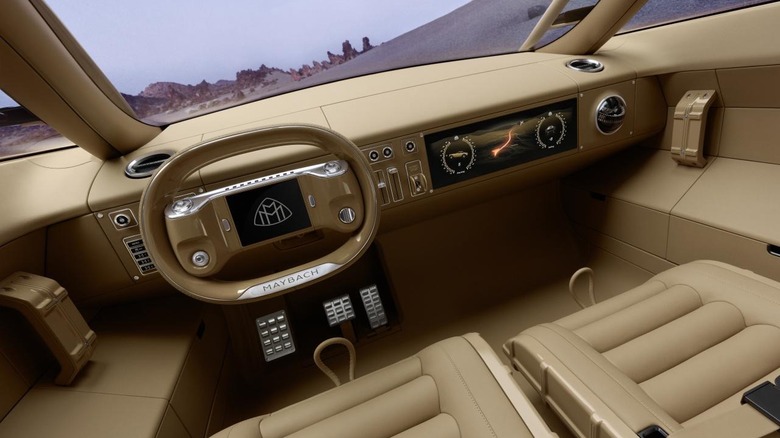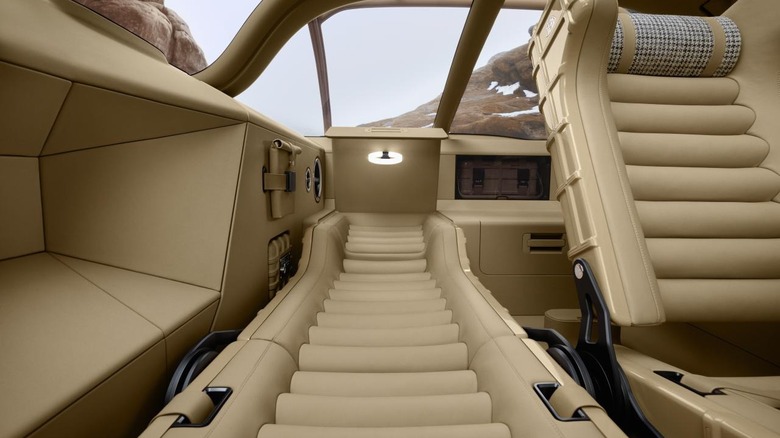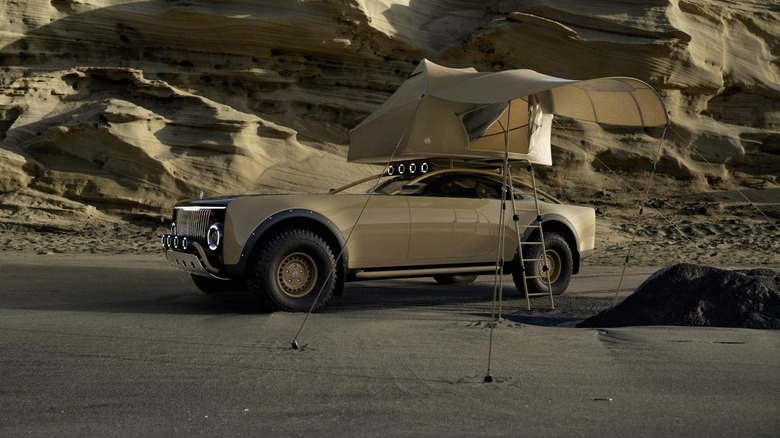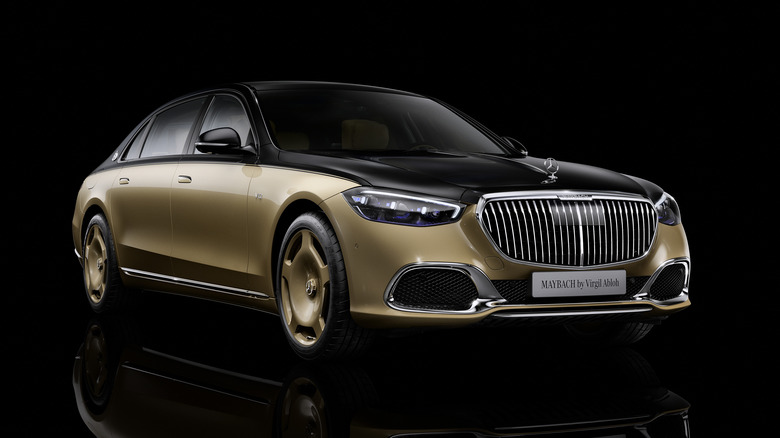The 10 Wildest Features Of The Mercedes Maybach Off-Roader
Mercedes-Benz recently debuted the Project Maybach Off-Roader concept, one of its wildest in years. The car is a collaboration between Gorden Wagener, the brand's Chief Design Officer, and Virgil Abloh, the founder of Off-White and former creative director of Louis Vuitton. Abloh passed away in 2021 after a battle with an aggressive form of cancer, making the Maybach Off-Roader one of his last-ever projects. The car is a world away from anything that Maybach has unveiled before, offering both ultra-exclusive luxury and a level of all-terrain practicality that's usually reserved for campers or overland SUVs.
It's a typically unconventional piece of Abloh's design, taking influences from places that Maybach usually wouldn't dream of. It's also full of little details that add character to the car, yet it's easy to overlook most of them at first glance. The Maybach Off-Roader is only a show vehicle, and it's highly unlikely to ever become a production reality. But, this lack of production constraints is what enabled Wagener and Abloh to rip up the rulebook and pack the car with some of the wildest features of any concept in recent memory.
Virgil Abloh's unique design
The first thing to note about the Maybach Off-Roader concept is just how different it looks from any previous Maybach model. Since Mercedes-Benz revived the brand at the turn of the century, Maybachs have been based on the best-selling S-Class limousine, and they have shared a lot of visual similarities with their less exclusive cousins. Abloh's concept is a world away, with a unique, almost Rolls-Royce-style front end, and rows of LED halo lights that feature on both the bull bars and the roof rack of the car.
It's perhaps best described as a remix of a regular Maybach, and it mirrors the work that Abloh created with his brand Off-White. Despite only being founded in 2012, Off-White quickly became the hottest new name in the fashion world by taking well-loved styles and adding unique elements, often mixing in eclectic inspirations alongside the brand's signature "quotation marks" branding. Abloh was also credited with rejuvenating Louis Vuitton's menswear line when he became Creative Director in 2018, and it seems Mercedes-Maybach might have been in the process of establishing a long-term partnership with him, too. Unfortunately, his untimely death ruled out any chance of that happening, with the Maybach Off-Roader concept being one of just two Mercedes projects helmed by the designer.
Plenty of Maybach branding
If there's one thing that regular Maybachs and Virgil Abloh's Off-White share in common, it's the need for prominent branding on all of their products. The Maybach Off-Roader concept is no different, with Maybach logos found all over the exterior and interior of the car. The traditional "MM" logo is found mounted to the front of the car in place of Mercedes' usual tri-star, and at the rear, the Maybach name is printed in the brand's distinctive typeface. The front and rear lights also have prominent Maybach logos in the center, which light up alongside the outer halos.
Move into the interior and things are equally brand-heavy, with the steering wheel displaying the MM logo and the seats also featuring prominent branding on the sides. In fact, it's difficult to look anywhere inside the car and not see a logo somewhere. In many ways, it seems like the car is reflective of the current trends in fashion, as "logomania" has become one of the most controversial yet enduringly popular features to emerge from contemporary fashion houses. Abloh's earlier work in the sector played a key part in popularizing those trends, so it seems fitting that he brought that distinct element of his design with him to his automotive work.
Maybach branded ax
While most of the branding on the car is designed to remind occupants and onlookers of the prestigious status of Maybach's latest creation, there are some quirkier touches to the design, as well. Embedded into the side of the car just behind the driver's seat is a Maybach branded ax, complete with a glass cover featuring "Emergency use only" lettering. It's a practical addition to the car in theory, although let's face it, the chances of any Maybach owner ever being in a situation where they have to resort to chopping their way out with an ax is virtually zero.
Perhaps it's a clever commentary on the ultimately superfluous nature of most high-end luxury car features, or perhaps Virgil simply thought the idea of a built-in ax in a Maybach coupe was funny. Either way, it joins the legions of other branded things in the car, which include a toolbox that slides into the dash, a smattering of industrial-looking gauges, and even the bolts that hold the seats together. There's no getting away from the fact that this is one of the most Maybach-branded Maybachs ever made.
Full roll cage
In many luxury cars, safety features like roll cages are an unsightly necessity, hidden away by strategically-placed pillars and lashings of leather or polished metal. The Maybach Off-Roader concept flips that idea on its head, wearing its rough-and-ready roll cage on its exterior for all to see. The structure of the cage rises from the hood of the car and stretches all the way over the passenger cabin, cleverly incorporating a roof rack with space for several suitcases or other pieces of luggage.
It would also, in theory, provide an extra layer of protection in the event of a rollover, although like the ax, it seems unlikely that any hypothetical owner would be in a situation where that would become useful. The cage is painted the same shade of Colorado beige as the rest of the bodywork, reinforcing the idea that, if it's done right, a roll cage can be incorporated into an elegant luxury design rather than simply hidden out of sight.
Hood-mounted solar panels
Sustainability is a word on every car manufacturer's radar right now, with more focus being given to the idea of eco-friendly vehicles than ever before. The Off-Roader plays into that theme by featuring a prominent set of solar panels mounted on its hood, which could be used to generate power to extend the range of the car. It's worth pointing out that this is all hypothetical, as the show car is non-functional, and has no drivetrain. Mercedes is keen to stress, though, that if the car did have a drivetrain, it would be all-electric, although no detail is given on the power or range that would be available to drivers.
The solar panels are interwoven with yet more Maybach logos, and their tinted finish makes them blend in almost seamlessly with the rest of the hood. It's been pointed out by industry analysts that adding solar panels to cars is not always as environmentally friendly as it might seem, as the panels are only able to generate a very small amount of power. That power can easily be consumed by the added A/C strain caused by parking a car out in the sun all day to charge it. Car-mounted solar panels might be a flawed idea in practice, but even so, it's interesting to see how Abloh was able to inconspicuously add them in without compromising the overall look of the car.
Sustainably made interior
The theme of sustainability continues through from the exterior to the car's interior, with many of the materials used in the Off-Roader concept being made using eco-friendly techniques. The leather that coats much of the car's interior surfaces was tanned naturally with coffee shells, for example, to minimize its environmental impact. The car seat headrest, which can be unfolded and used as an overnight blanket, features a mix of hand-dyed cotton and wool that Mercedes' press release calls "locally sourced," although it provides no further explanation on how the term "locally" is defined here.
Alongside some highly polished aluminum, that's largely it in terms of interior materials for the Maybach Off-Roader. Rather than featuring a large range of materials in search of ultimate opulence, it seems Abloh's strategy was to keep things simple, focusing on the quality of the few types of finish that were used more than the quantity.
Futuristic dash
With such an unusual overall design, it would be only right to expect the Off-Roader concept's dashboard to be equally full of surprises. It doesn't disappoint, as right off the bat, a prominent (and very shiny) brake button is positioned to the left of the steering wheel instead of a regular electronic parking brake. A spherical compass is built into the dash on the opposite side of the car, and between the two is a panel with various switches and buttons that can be rotated to reveal a huge screen.
If it were a fully-functioning car, this screen would likely be where the car's infotainment systems and settings like climate control could be adjusted, but since it's only for show, occupants can play a specially-made video game on it instead. It's a neat feature, but one that's not unique, as Tesla also offers a number of games in its production cars. There have been some questions raised around the safety of this feature, but Tesla CEO Elon Musk has continued development regardless, even promising Steam integration in the near future.
Fold-flat seats
It might feature stunningly unconventional design and ultra-luxury finishes, but the utilitarian nature of the car is still evident in the cabin. Most notable are the seats, which fold completely flat and fit into specially-designed headrests in the rear of the car. As previously mentioned, the regular seat headrest also folds out into a blanket, leaving occupants primed for a good night's sleep in just a few simple steps. The car's panoramic sunroof means that there won't be much privacy, though, so drivers would have to make sure they were in a suitably private place before bedding down for the night.
There's no need to worry when it gets dark either, as the bed's headrests in the rear feature small ring lights that illuminate the back of the car, allowing its occupants to read or, probably more likely, scroll through social media before they go to sleep. The concept's cavernous proportions and plentiful storage compartments mean there's more than enough room for overnight luggage, so adventurous weekends in the wilderness should be a breeze.
Attachable roof tent
If camping in the cabin isn't quite enough for some drivers, the roof rack also features mounts for a roof tent, which comes with an extendable canopy to protect against the elements. The official pictures show a space that seems big enough for one person comfortably or two at a push. With the tent fitted and the canopy and ladder extended, the Maybach could pass as an overland rig, albeit one that's a lot longer and grander than most.
Helping add to the overlander effect are the chunky BFGoodrich tires, which sit on 17" rims. Tires this big aren't known for their on-road comfort, and so if a production Maybach off-roader did ever materialize, it remains to be seen how the brand could tackle this. As a non-functional concept, though, the Maybach Off-Roader can overlook such issues, and the result is a luxury car that simply looks like nothing else in the industry.
Production car inspired by the concept
While the Off-Roader concept might be little more than a ruggedly glamorous rolling shell, Mercedes also unveiled a limited run of Maybach S-Classes alongside the concept that will make it to production. The Limited Edition Maybach by Virgil Abloh celebrates the designer's work by mirroring many of the design cues from the Off-Roader concept, including the distinctive Colorado beige and black two-tone paint job. It's available in highly limited numbers, and buyers will receive a custom-made 1/18th replica of their car inside a commemorative wooden box with Abloh and Maybach's logo.
The car's user interface will also be unique, with parts of the MBUX system customized with changes that Abloh picked himself. Mercedes also hinted that other elements of Abloh's design work on the concept might make it into a production Maybach one day, saying "[we] thank Virgil Abloh for the inspiration to explore every day the power of cross-industry dialogue to imagine a better, more inclusive future."
